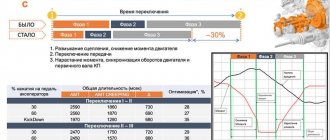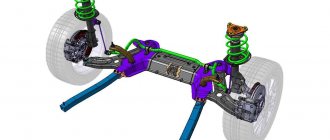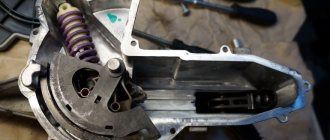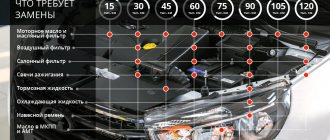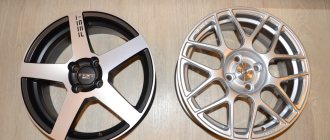The robotic gearbox is a joint development of AvtoVAZ together with the German company zf.
How does a “robot” work?
The robot is still the same 2180 gearbox with a cable drive with redesigned mounts, but in addition with an installed automatic shift mechanism, which was developed by the German company ZF. The automatic “actuator” mechanism depresses the clutch for you, puts the gear in gear, and releases the clutch.
The robot selector has the following positions:
N – neutral
R – reverse gear
M – manual switching mode
Vesta robot control diagram
Prices
In identical configurations, the robot requires an additional payment for the “handle” of 25,000 rubles, regardless of the engine - 1.6 or 1.8. But these are 2021 cars. The CVT on cars produced in 2021, if you count the difference with the base 1.6 engine with manual transmission, raises the price by 95 thousand. Quite a lot! Regarding the 1.8‑liter engine, the surcharge is less - 60 thousand rubles.
Reduced gear shift time: AMT 2.0 compared to the previous version, ms
| Percentage of pressing the accelerator pedal | From first to second | From second to third |
| 30 | 730 | 720 |
| 60 | 690 | 880 |
| 100 | 680 | 550 |
Reviews from car owners
| № | Positive |
| 1. | Vladimir , 37 years old (drive2.ru): I like the AMT on the Lada Vesta, it’s better than the manual one. It's unusual to control gears with the gas pedal. The harder you press the accelerator, the lower the gear becomes. To change to increased speed after a kickdown, release the pedal a little. In general, you need to get used to it. At first I was confused about what and how. Once I almost collided with the vehicle in front. |
| 2. | Dmitry , 42 years old (prom.ua): I bought Vesta last year with AMT. I had some doubts about the correctness of my choice, but overall I am pleased with the results of a year of operation. Shifts are not the fastest, but quite tolerable. The torque converter in the first models had better smoothness. I had a chance to drive old versions of Vesta. On the highway, the car is economical, rides smoothly, quickly picks up speed, and is maneuverable when overtaking. I drove 17,000 km without capital investments, repairs, only scheduled maintenance. My review of the Lada Vesta automatic is only positive. |
| 3. | Alexey , 38 years old (drom.ru): The first few hundred kilometers the impressions were incomprehensible. I haven’t encountered AMT before, only manual and CVT. The first “step” was as if according to the instructions: I got behind the wheel, turned on the automatic mode on the transmission, released the brake, increased the gas and drove off. It’s not entirely clear why it shifts to fifth gear already at 80 km/h. This is low for a car with such an engine. Therefore, I switch to the manual, dial 90 - 95 km/h, and then engage fifth. The motor allows you to reach a speed of up to 125 km/h in fourth gear. I noticed that Vesta’s consumption on the robot is 0.5 liters less than the manual one. It's a small thing, but nice. |
| 4. | Petrovich , 47 years old (rozetka.ua): Before the Lada Vesta Cross automatic, I had an Opel Corsa, I took the Lada in the Comfort configuration with a radio. It took me a while to get used to AMT, and I even got confused. I avoided traffic lights on the “tenth road” so as not to mess things up. In general, the opinion is positive about the box, too. In comparison with mechanics, the transition to higher gears is a little slower, but this is not important for me. The good news is that you don’t need to warm it up in the cold for a long time. I sat down, started it for 3 minutes and drove off. The accelerator is very sensitive, it needs adaptation after the mechanics. I hope that the resource of 75,000 km goes out with a bang. |
| Negative | |
| 5. | Gennady Dmitrievich , 53 years old (prom.ua): Lada Vesta Station wagon automatic for a year, has already driven 18,000 km, I think this is above average. The robot works properly, but there is a rustling noise from time to time. At the service station they said that the release bearing needs to be tightened. The car is new, but already forced to repair something. It is obvious that the quality of the domestic manufacturer is not yet at the proper level, the model is crude and requires improvements. |
| 6. | Vladimir , 48 years old (Bibika.ru): first experience with a robotic gearbox, and a sad one. The release bearing failed at 15,000 km and was replaced at the workshop under warranty. After the seal leaked, I also had to replace it. I am dissatisfied with the quality, I think that the model needs careful improvement. |
| 7. | Semyon Sergeevich , 49 years old (drive2.ru): I took a Lada Vesta from scratch, there were no complaints about the work. After winter, the gears began to engage with a delay, and the clutch began to slip. In general, I visited the service station and agreed on a comprehensive diagnosis under warranty. My comrades advised me to take a manual, but I didn’t listen and took an automatic. |
| 8. | Stepan Vasilyevich , 45 years old (Avtodispatcher.ru): after two years of active operation of the Lada Vesta Cross, the release bearing flew off. I think that this is not my fault, since I drove carefully, did not drive, and treated it with care. |
Doesn't break anymore
I know firsthand how both options behave. I tested the CVT Vesta in the Caucasus and drove it in Moscow. And I’ve been living side by side with the robotic Vesta for 4.5 years now and have driven more than 90,000 km.
Life together with the robot did not work out right away. It is the driver who must adapt to it, and not vice versa! So, if you are looking closely at the “automated” Vesta of the first years of production (on the secondary market), keep in mind: you need to be a very calm driver with nerves of steel so that the box does not irritate you.
After about a year and a half in Tolyatti, the problem of the rapid death of the clutch was corrected. It turned out to be so gentle that even slow shifts did not help. On my car, the clutch kits lasted 20,000 and 18,000 km, and for some, the first signs of wear appeared after 5000–7000 km!
Now the third, reinforced clutch is coming to an end on the editorial car. You'll be lucky if it lasts 60,000 km (that is, up to 98,000 on the odometer). In general, you need to be prepared for quick repairs - and when buying a used Vesta, I would consider the original factory kit as a minus. Especially if it is an old model.
The Renault-Nissan 1.6 engine (113 hp) lacks a decorative cover. Let be! On a VAZ engine it is attached to flimsy pegs that are prone to getting lost. It does not protect from dirt outside and from engine noise - only decoration.
The Renault-Nissan 1.6 engine (113 hp) lacks a decorative cover. Let be! On a VAZ engine it is attached to flimsy pegs that are prone to getting lost. It does not protect from dirt outside and from engine noise - only decoration.
Interestingly, the clutches of the first and second versions signal wear differently. The old clutch begins to respond with shocks in traffic jams, and the car shakes in convulsions at the beginning of movement. The modernized one behaves intelligently, reminding of wear with exceptionally soft slipping, clearly visible in the timbre of the engine and tachometer readings. Therefore, now I will drive all the way, but I changed the previous sets preventively: I did not have the strength to endure their hysterics.
Malfunctions and ways to eliminate them
| Malfunctions | Remedies |
| Shocks when transitioning between 1st – 2nd – 3rd gear | Prevention and replacement of the clutch disc, basket, bearing, guide bushing |
| Hum, rustling in the area where the AMT is located | The contact point of the clutch disc is shifted |
| Clutch slipping, loss of traction | Insufficient transmission oil level in the gearbox |
| The car moves jerkily | Clogged lubricant supply channels in the valve body. Cleaning, blowing with a stream of compressed air |
| Periodic emergency operation with self-shutdown | The electrical supply circuit is damaged. Checking integrity with a multimeter, replacing sections |
To go or guarantee?
How to buy a car with adequate AMT? There are two options. The obvious one is to choose version 1.8. An alternative is to go to unofficials for new firmware. Craftsmen with a laptop can reflash any Granta, Vesta or Xray for 2000–3000 rubles and 20–30 minutes. The engine and year of manufacture do not matter. We did this too. Moreover, they downloaded more advanced software to us than the factory one. It also has a sports mode, in which the engine is more willing to rev to the top, and the gearbox feels even a little more agile.
Design features and device of the JR5 Lada Vesta gearbox
The domestic robot largely copies the boxes of the German concern ZF. The AMT actuator consists of:
- clutch activation actuator;
- speed change actuator;
- clutch forks;
- backstage for controlling gears inside the car;
- input shaft speed sensor.
The design of a typical robot with electric drive and a single clutch disc. In Europe and Asia, such technology was abandoned five years ago in favor of preselective models, but on the domestic market this is a new product.
If savings are important, then your option is 1.6 with a robot.
Service life of AMT according to instructions and actual
The AvtoVAZ manufacturer indicates a warranty life of an automatic transmission of 75,000 km or 5 years.
In general, AMT takes care of the designated resource, but already in the first ten it is necessary to carry out small works:
- replacing the clutch disc;
- flashing of the electronic control unit;
- tightening the pressure bearing;
- replacing the sealing gland on the AMT.
Conclusion
The presence of a robotic version of the gearbox on the Lada Vesta was greeted positively by many car enthusiasts. Although breakdowns do occur, they are not critical; in some cases they can be prevented by careful driving and timely maintenance. The final decision rests with the owner of the technical device.
Consumption
Fuel consumption 1.8l with AMT
:
Fuel consumption 1.6l with CVT
:
The average speed is almost equal, and the difference in gasoline consumption is 3.5 liters! With a full tank, Vesta with AMT can travel 387 km, and with a CVT 537 km. Over 20 thousand kilometers (about a year of operation) you will spend 118,680 and 85,560 rubles on gasoline, respectively. The CVT is more economical by 33,120 rubles per year
. The difference over three warranty years will be about 100 thousand rubles.
Bottom line
I definitely wouldn’t take the 1.8 AMT for myself, let alone my wife. Which, in principle, happened about a year and a half ago, as soon as AMT came out, then it was still 1.0. I took it for a test and decided not to change the Corsa for now, it’s not better. A crude robot, it eats a lot, the dynamics are not amazing. Maslozher at 1.8 is a very common occurrence. No matter what anyone writes about the h4m, there are many times more of them produced than the VAZ 1.8, and there are no fewer articles on the Internet about the h4m oil burner in quantitative terms. So consider it more reliable.
writes the author.
The variator has been partially strengthened, repairs are not so expensive, and the savings on fuel will more than offset the repair of the variator. And most importantly, with this combination the car looks like a NORMAL BUDGET car. Suitable for use in the city and on highways. An adequate replacement for B classes from Koreans and others with automatic transmissions, at a lower price. The quality of the components would also be improved.
he adds.
Have you felt the difference between a CVT and a robot? Which transmission did you choose?

